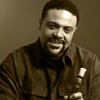
 World woodwinds player and duduk master
World woodwinds player and duduk master
That's the soulful sound of the duduk. The duduk is a kind of folk oboe from
The duduk has become the stuff of
Venezuelan-born musician Pedro Eustache was haunted by the sound of this mysterious instrument.
Pedro: ?I said what the heck is that? It sounded like a cello meets a voice, meets a clarinet, meets a lot of pain, incredibly expressive and it just rocked my world.?
Eustache took up the duduk in 1994 and studied with master Djivan Gasparyan. He soon learned the secrets of this rudimentary instrument made of Armenian apricot wood. It's topped with a large reed that sounds like this:
Eustache is a freelancer and in
Pedro: Duduk is such a difficult instrument, pfffff…..it kicks my butt all the time, excuse my French–which is not French– but duduk can express something very specific, peculiar, particular, that nothing else can express. I would say evocative, I would say extreme expression from sweetness to pain and they say in
That quasi-holy sound has made the duduk a welcomed guest in religious film epics. In 2004, 16 years after “the last temptation of Christ ” the duduk appeared in Mel Gibson's film “the Passion of the Christ.” And this time, Eustache was playing.
More than an instrument, the duduk is a dramatic device. John Debney composed the score for “the Passion of the Christ.” He says he chose the duduk because it sounds just like a human voice. But he says that usually when film composers use it, they aim to refer to the distant past and distant lands.
Debney: ?It does evoke something ancient. I think that most westerners are drawn to this instrument because it is a plaintive instrument that is very exotic and very beautiful. And I think that's very appealing.?
Filed under “ancient times” evoked by the duduk, you find the films “Gladiator” and “Alexander.” And as for exotic, in 2005 alone, the duduk evoked a fictitious land in “Chronicles of Narnia,” and the middle east in “Syriana” and “
Pedro Eustache is the featured duduk player in
Eustache: ?I've played this in churches, in Hispanic churches, I have played this in huge arenas all over the world, I have played this from Dubai to India to Japan to Venezuela, I've used this in Iranian pop, you know, it's pretty amazing.?
Eustache also performs with classical Indian music master Ravi Shankar. In 2002, Eustache performed with Shankar and his band in
McCartney: ?He said that he called Ravi Shankar….and said “Ravi, I want to have that Indian musician that plays this mournful Indian instrument…. voovoovoo…. and Ravi said “No no no, he's not Indian, he's from Venezuela and the instrument is from Armenia.. hahaha…?
McCartney called Eustache and invited him to play a duet on his latest album “Chaos and creation in the garden.” The song is “Jenny Wren.”
Pedro Eustache is convinced that this folk horn from
Eustache: ?I'm from
Its appeal is so universal that last November, UNESCO issued a proclamation naming duduk music a “Masterpiece of the Oral and Intangible Heritage of Humanity.”
As for Eustache, he'll next play on a couple of songs Stevie Wonder is writing for a documentary. Eustache says the R'N'B star loves the instrument so much he's getting one for himself. The duduk's next appearance will be brought to the silver screen by composer Hans Zimmer. Zimmer asked master Djivan Gasparyan to the play for the soundtrack of “The Da Vinci Code,” out this May.
For the World, I'm Adeline Sire.
Pedro Eustache is a woodwind player and a duduk specialist.
For information about Pedro Eustache and his latest solo CD, go to:
View article at the following link:
http://www.theworld.org/globalhits/2006/04/03.shtml
Download the audio version of the above text (with duduk samples):
http://audio.theworld.org/mp3/glohit/04032006.mp3
Source:
http://www.theworld.org/, April 3, 2006, Global Hit Podcast
The Global Hit podcast, a daily spotlight on international musical artists or trends. Created by The World's Marco Werman, The Global Hit features interviews with musicians, critics and deejays around the globe.
